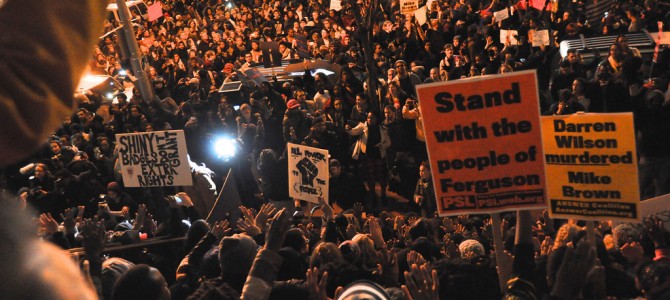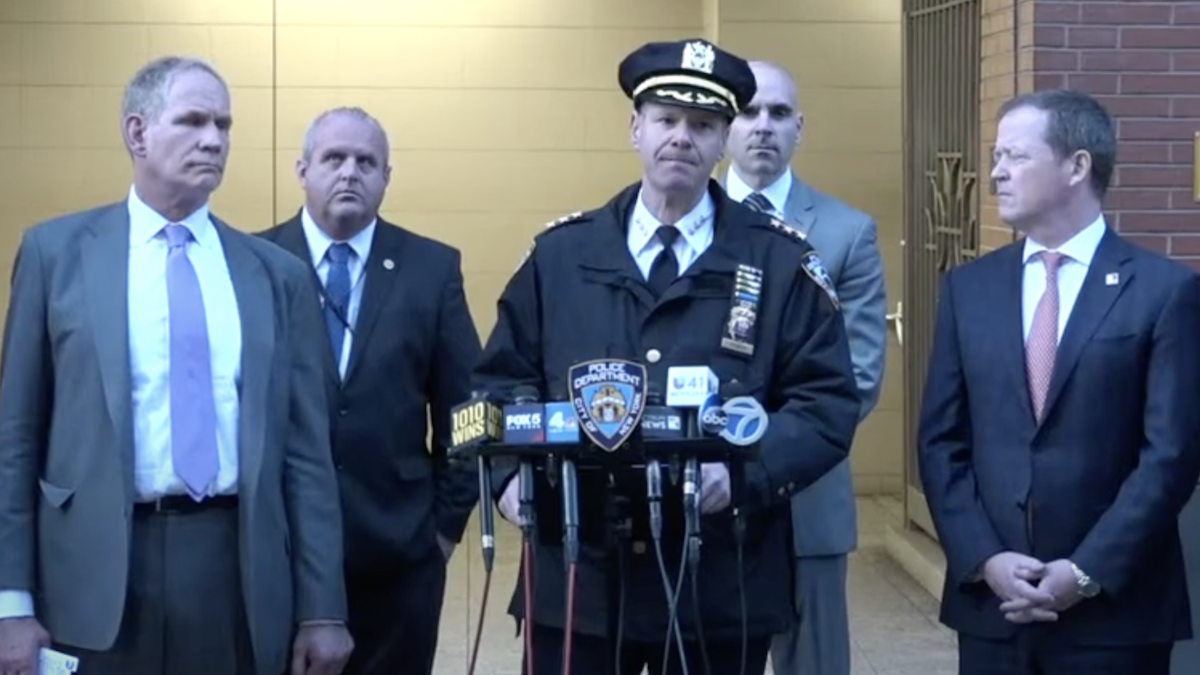
The demonstrations and riots in Ferguson, Missouri, had burned themselves out, in part because it was hard to sustain the outrage against “racist cops” after the narrative about the shooting of Michael Brown fell apart.
No, he wasn’t an innocent kid; he was a brutish strong-arm robber. No, police officer Darren Wilson did not attack Brown; it looks like it was the other way around, just as the officer claimed. And no, Brown did not have his hands up and wasn’t imploring the officer not to shoot; he had turned around and was charging toward him. So the whole “hands up, don’t shoot” narrative—trumpeted in the media for months—was based on a lie.
And yet now the Ferguson riots are back, reinflamed, resulting in the shooting of two police officers late last week by an attacker who was just arrested by Ferguson police. (Early reports indicate that he claims he was shooting at someone else and not at police. That seems implausible, but we’ll see how it holds up.)
How did this happen? Well, in part it was because the Ferguson Narrative was resurrected—and it was resurrected deliberately.
It was resurrected by the Justice Department report on the shooting of Michael Brown. Rather than limiting its investigation to the shooting itself and whether it was a violation of civil rights, the DOJ paired the report on the shooting with a wider investigation into the practices of the Ferguson, Missouri, police department and came back with a sweeping indictment of the city for racial animus and the deliberate targeting of black residents for police harassment and the constant financial drain of fines imposed for petty infractions.
You can see why they did this. The evidence compelled the DOJ to exonerate Darren Wilson and disavow every single piece of the “hands up, don’t shoot” narrative. But the report branding the Ferguson PD as racists allows them to resurrect that narrative.
So perhaps we should call this the Trovato Report—after Ben Trovato, the king of the narrative—because its purpose was not to examine the facts of this particular case, but to preserve the wider narrative of a nation so corrupted by institutional racism that it uses the police as a weapon to harass and intimidate blacks.
Special Trovato awards should go to folks like Jamelle Bouie and Ta-Nehisi Coates for the way they treated the report’s conclusions about Darren Wilson—completely validating the decision of the Ferguson grand jury and undermining every press hack who jumped on the Ferguson bandwagon—as a mere speed bump to rattle over on their way to the new narrative. Coates was the more gracious of the two, spending a few paragraphs to name in detail the report’s conclusions about Brown and Wilson.
The investigation concluded that physical evidence and witness statements corroborated Wilson’s claim that Michael Brown reached into the car and struck the officer. It concluded that claims that Wilson reached out and grabbed Brown first “were inconsistent with physical and forensic evidence.”
The investigation concluded that there was no evidence to contradict Wilson’s claim that Brown reached for his gun. The investigation concluded that Wilson did not shoot Brown in the back. That he did not shoot Brown as he was running away. That Brown did stop and turn toward Wilson. That in those next moments “several witnesses stated that Brown appeared to pose a physical threat to Wilson.” That claims that Brown had his hands up “in an unambiguous sign of surrender” are not supported by the “physical and forensic evidence,” and are sometimes, “materially inconsistent with that witness’s own prior statements with no explanation, credible for otherwise, as to why those accounts changed over time.”
But both writers moved on promptly to the claim that the police are the “true criminals” in Ferguson, according to Bouie—he makes no mention of the rioters who burned the city’s small businesses and makes no attempt to gauge how true their criminality was. Or that the cops are “gangsters,” according to Coates—who then goes on to browbeat blacks who believe in “personality responsibility” rather than chalking up everything to the vast conspiracy of “white supremacy.” And to explain why he was perfectly justified in assuming Wilson’s guilt. And, inevitably, to conclude that, “The innocence of Darren Wilson does not change this fundamental fact.”
You can see the Ben Trovato Rules in action. When you change narratives, never acknowledge the existence of your previous narrative if you can at all avoid it, and for God’s sake never apologize for getting the old narrative completely wrong. Always remember that individual facts may die, but the narrative lives on.
As it turns out, the new narrative has a few of its own problems with the facts. John Lott, former chief economist for the United States Sentencing Commission, notes that the DOJ report depends almost solely on statistics seeming to show disparities in how frequently Ferguson’s blacks are pulled over by officers or have arrest warrants issued for them. But these statistics are meaningless on their own, without controlling them for outside factors.
The Bureau of Justice Statistics’ 2011 Police-Public Contact Survey indicates that, nationwide, blacks were 31 percent more likely than whites to be pulled over for a traffic stop.
Ferguson is a black-majority town. If its blacks were pulled over at the same rate as blacks nationally, they’d account for 87.5 percent of traffic stops.
In other words, the numbers actually suggest that Ferguson police may be slightly less likely to pull over black drivers than are their national counterparts. They certainly don’t show that Ferguson is a hotbed of racism….
In fact, blacks die in car accidents at a rate about twice their share of car owners…. This suggests that there are a lot of unsafe black drivers, not racism.
As for direct evidence of racial animus, the report relies on “seven emails from Ferguson police officers from 2008 to 2011,” which were deemed “offensive” by the DOJ investigators. Which seems like awfully few to be the smoking gun for systemic white supremacy.
And yet the report does uncover some real, serious problems in the way local governments are using, and misusing, law enforcement. But this has less to do with white than with green—less to do with racism than with an insatiable lust for government revenue, raised through a vast array of petty fines imposed on the citizenry. Black people in Ferguson were disproportionately poor and thus disproportionately hit by these nickle-and-diming fines. Here’s where the DOJ’s report hits home:
Ferguson’s law enforcement practices are shaped by the City’s focus on revenue rather than by public safety needs. This emphasis on revenue has compromised the institutional character of Ferguson’s police department, contributing to a pattern of unconstitutional policing, and has also shaped its municipal court, leading to procedures that raise due process concerns and inflict unnecessary harm on members of the Ferguson community…. Partly as a consequence of City and FPD priorities, many officers appear to see some residents, especially those who live in Ferguson’s predominantly African-American neighborhoods, less as constituents to be protected than as potential offenders and sources of revenue.
This is backed up by evidence of Ferguson officials boasting, not about a reduction in crime rates or the superior safety of the streets, but about exceeding their targets for city revenue from fines. Racism is almost certainly a factor here, but it is a kind of opportunistic infection that gains purchase within a corrupt and corrupting system. When city officials wield so much arbitrary power, they are certainly going to be tempted by favoritism and blinded by indifference toward the sort of people they don’t like. For example, Ferguson’s municipal judge had designed a regime of niggling court fees—yet he was caught fixing parking tickets for his friends and owing $170,000 in unpaid personal and business taxes.
All of this reminded me of the story behind the killing of Eric Garner in Staten Island, who died while resisting arrest for the utterly trivial offense of selling loose, untaxed cigarettes on a street corner. As I argued in that case, the more the police are tasked to enforce a vast array of petty controls—or revenue-raising fines—the more they are put into rough contact with the citizenry, with the potential for damage to the citizens’ dignity, their wallets, and their lives.
The real story here is summed up by an image that has been making its rounds on the Internet: a photo showing a horde of Occupy-style protesters on one side, marked with the label “wants more government”—clashing with police on the other side, who are marked with the label “more government.” (Here’s another variation.)
All of this could define an agenda for the reform that is really needed, not just in Ferguson, but in cities across the country. But it won’t be pursued, because it’s not part of the right narrative. It’s about limiting the reach of government and its attempts to raise revenue from citizens—whereas the left wants a narrative about how all-pervasive government would work just fine if it weren’t for those racist rednecks out there who keep abusing it.
So that’s what the DOJ’s Trovato Report delivered for them.
Follow Robert on Twitter.









